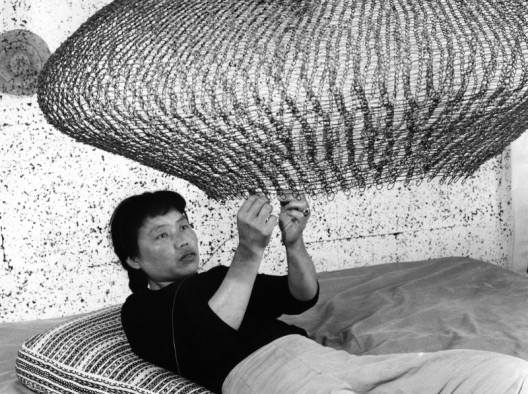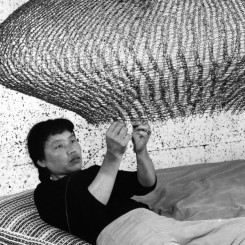David Zwirner is pleased to announce that the gallery will exclusively represent the Estate of Ruth Asawa and that Jonathan Laib has joined the gallery as Director.
An influential sculptor, devoted activist, and tireless advocate for arts education, Ruth Asawa is best known for her extensive body of hanging wire sculptures. Intricate, dynamic, and sinuous, these remarkable works, begun in the late 1940s, continue to challenge conventional notions of sculpture through their emphasis on lightness and transparency. Explaining her fascination with wire as a material, Asawa said, “I was interested in it because of the economy of a line, making something in space, enclosing it without blocking it out. It’s still transparent. I realized that if I was going to make these forms, which interlock and interweave, it can only be done with a line because a line can go anywhere.”1
As David Zwirner notes, “The gallery is proud to be entrusted with the extraordinary legacy of Ruth Asawa, who started her career at Black Mountain College under Josef Albers’s tutelage. The intense focus of her work and the modesty of the materials align her closely with Yayoi Kusama, both of whom in the 1950s foreshadowed the reductivist and minimalist tendencies of the 1960s. I am pleased that Asawa’s work is gaining the recognition it deserves. It is surprising that it has taken this long for her work to be widely understood and appreciated. I think her story, if properly told, should afford her a place amongst the great artists of the twentieth century.”
The Estate of Ruth Asawa comes to the gallery through Jonathan Laib, who joined the gallery this month as Director. Laib was previously a Senior Vice President, Senior Specialist in Postwar & Contemporary Art at Christie’s auction house, where he worked for 17 years. He was active in pursuing and creating private selling exhibitions at Christie’s before these practices became commonplace at auction houses. In 2013 and 2015, he organized two exhibitions at Christie’s dedicated to the work of Asawa, then under-known, to much critical acclaim. He is regarded as the authority on Asawa and will continue to work with the artist’s estate at David Zwirner. Laib will be based in New York.

Ruth Asawa, 1957. Photo: Imogen Cunningham © 2017 Imogen Cunningham Trust. Artwork © Estate of Ruth Asawa
Ruth Asawa (1926-2013) was born in rural California to Japanese immigrants barred from land ownership and American citizenship; during the Second World War, she and her family were detained in internment camps. Originally housed for five months in the stables of the Santa Anita Park racetrack, they were eventually relocated to Rohwer, Arkansas, where Asawa graduated from the camp’s high school in 1943. It was during her internment in Santa Anita, however, that Asawa discovered professional artists, learning to draw from Walt Disney animators who were likewise interned.
Following her release in 1943, she enrolled in Milwaukee State Teachers College, but was unable to receive her degree due to continued hostility against Japanese Americans. In 1946, Asawa began to study at Black Mountain College in North Carolina, renowned at the time for its progressive pedagogical methods and avant-garde aesthetic milieu. Here, Asawa absorbed the vital teachings and influences of Josef Albers, Buckminster Fuller, and Merce Cunningham, among others, and embraced her own vocation as an artist. It was at Black Mountain that Asawa began to explore wire as a medium, inspired by a 1947 trip to Mexico during which local craftsmen taught her how to loop baskets out of this material.
In addition to her wire sculptures, Asawa is well known for her public commissions, particularly in San Francisco and the wider Bay Area. These include the much beloved fountains in Ghirardelli Square (1968) and outside the Grand Hyatt San Francisco (1973), the latter of which comprises hundreds of clay images molded by local schoolchildren, friends, and other artists cast in bronze. Upon moving to San Francisco in 1949, Asawa, a firm believer in the radical potential of arts education from her time at Black Mountain College, devoted herself to expanding access to art-focused educational programs. She co-founded the Alvarado Arts Workshop in 1968 and was instrumental in the opening of the first public arts high school in San Francisco in 1982, which was renamed the Ruth Asawa San Francisco School of the Arts in her honor in 2010. Asawa believed that “Art will make people better, more highly skilled in thinking and improving whatever business one goes into, or whatever occupation. It makes a person broader.”
Asawa has exhibited widely throughout the world since the early 1950s. In 1965, Walter Hopps organized a solo exhibition of the artist’s sculptures and drawings at the Pasadena Art Museum (now Norton Simon Museum) in California, where the artist completed a residency at the Tamarind Lithography Workshop the same year. Other solo presentations include those held at the San Francisco Museum of Art (1973); Fresno Art Museum, California (traveled to Oakland Museum of California; 2001-2002); de Young Museum, San Francisco (2006); Amon Carter Museum of American Art, Fort Worth, Texas (2012); and Norton Simon Museum of Art, California (2014).
Work by the artist has been included in a number of major group exhibitions, including the Annual Exhibition at the Whitney Museum of American Art, New York (1955 and 1958); the São Paulo Biennial (1955); and The Museum of Modern Art, New York (1959), among others. Most recently, her work was featured in the critically acclaimed traveling group exhibition Leap Before You Look: Black Mountain College 1933-1957, held at the Institute of Contemporary Art, Boston; Hammer Museum, Los Angeles; and Wexner Center for the Arts in Columbus, Ohio. In 2015, her work was on view as part of America is Hard to See, the inaugural exhibition at the Whitney Museum of American Art’s new building. Other recent group exhibitions include Revolution in the Making: Abstract Sculpture by Women, 1947-2016, Hauser Wirth & Schimmel, Los Angeles; Black Mountain College: Shaping Craft + Design, Black Mountain College Museum Arts + Center, Asheville, North Carolina (2013); The Art of Gaman: Arts and Crafts from the Japanese American Internment Camps, 1942-1946, Renwick Gallery, Smithsonian American Art Museum, Washington, D.C. (2010).
The artist’s work is represented in prominent museum collections, including the de Young Museum, San Francisco; The Museum of Modern Art, New York; San Francisco Museum of Modern Art; San Jose Museum of Art, California; and Whitney Museum of American Art, New York; and Crystal Bridges Museum of American Art, Bentonville, Arkansas, among others. Asawa has been the recipient of numerous prestigious awards.
1 Ruth Asawa quoted in Douglas Martin, “Ruth Asawa, an Artist Who Wove Wire, Dies at 87,” The New York Times(August 17, 2013).
